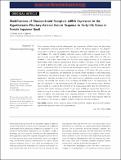Files in this item
Modifications of glucocorticoid receptors mRNA expression in the hypothalamic‐pituitary‐adrenal axis in response to early-life stress in female Japanese quail
Item metadata
| dc.contributor.author | Zimmer, Cédric | |
| dc.contributor.author | Spencer, Karen A | |
| dc.date.accessioned | 2014-12-03T15:01:01Z | |
| dc.date.available | 2014-12-03T15:01:01Z | |
| dc.date.issued | 2014-11-17 | |
| dc.identifier | 156419147 | |
| dc.identifier | 72e5afa9-16e2-4a10-bdde-6d7e07f1e41e | |
| dc.identifier | 25303060 | |
| dc.identifier | 84910683960 | |
| dc.identifier | 000345337700003 | |
| dc.identifier.citation | Zimmer , C & Spencer , K A 2014 , ' Modifications of glucocorticoid receptors mRNA expression in the hypothalamic‐pituitary‐adrenal axis in response to early-life stress in female Japanese quail ' , Journal of Neuroendocrinology , vol. 26 , no. 12 , pp. 853-860 . https://doi.org/10.1111/jne.12228 | en |
| dc.identifier.issn | 0953-8194 | |
| dc.identifier.other | ORCID: /0000-0002-2851-9379/work/78204993 | |
| dc.identifier.uri | https://hdl.handle.net/10023/5864 | |
| dc.description | The present study was funded by a BBSRC David Phillips Research Fellowship to KAS. | en |
| dc.description.abstract | Stress exposure during early‐life development can programme individual brain and physiology. The hypothalamic‐pituitary‐adrenal (HPA) axis is one of the primary targets of this programming, which is generally associated with a hyperactive HPA axis, indicative of a reduced negative‐feedback. This reduced feedback efficiency usually results from a reduced level of the glucocorticoid receptor (GR) and/or the mineralocorticoid receptor (MR) within the HPA axis. However, a few studies have shown that early‐life stress exposure results in an attenuated physiological stress response, suggesting an enhance feedback efficiency. In the present study, we aimed to determine whether early‐life stress had long‐term consequences on GR and MR levels in quail and whether the effects on the physiological response to acute stress observed in prenatally stressed individuals were underpinned by changes in GR and/or MR levels in one or more HPA axis components. We determined GR and MR mRNA expression in the hippocampus, hypothalamus and pituitary gland in quail exposed to elevated corticosterone during prenatal development, postnatal development, or both, and in control individuals exposed to none of the stressors. We showed that prenatal stress increased the GR:MR ratio in the hippocampus, GR and MR expression in the hypothalamus and GR expression in the pituitary gland. Postnatal stress resulted in a reduced MR expression in the hippocampus. Both early‐life treatments permanently affected the expression of both receptor types in HPA axis regions. The effects of prenatal stress are in accordance with a more efficient negative‐feedback within the HPA axis and thus can explain the attenuated stress response observed in these birds. Therefore, these changes in receptor density or number as a consequence of early‐life stress exposure might be the mechanism that allows an adaptive response to later‐life stressful conditions. | |
| dc.format.extent | 8 | |
| dc.format.extent | 444837 | |
| dc.language.iso | eng | |
| dc.relation.ispartof | Journal of Neuroendocrinology | en |
| dc.subject | Prenatal stress | en |
| dc.subject | Postnatal stress | en |
| dc.subject | Mineralocorticoid receptor | en |
| dc.subject | Glucocorticoid recpetor | en |
| dc.subject | Hypothalamic-pituitary-adrenal axis programming | en |
| dc.subject | BF Psychology | en |
| dc.subject | RC0321 Neuroscience. Biological psychiatry. Neuropsychiatry | en |
| dc.subject | BDC | en |
| dc.subject.lcc | BF | en |
| dc.subject.lcc | RC0321 | en |
| dc.title | Modifications of glucocorticoid receptors mRNA expression in the hypothalamic‐pituitary‐adrenal axis in response to early-life stress in female Japanese quail | en |
| dc.type | Journal article | en |
| dc.contributor.sponsor | BBSRC | en |
| dc.contributor.sponsor | BBSRC | en |
| dc.contributor.institution | University of St Andrews. School of Psychology and Neuroscience | en |
| dc.identifier.doi | https://doi.org/10.1111/jne.12228 | |
| dc.description.status | Peer reviewed | en |
| dc.identifier.grantnumber | BB/L002264/1 | en |
| dc.identifier.grantnumber | BB/L002264/1 | en |
This item appears in the following Collection(s)
Items in the St Andrews Research Repository are protected by copyright, with all rights reserved, unless otherwise indicated.

